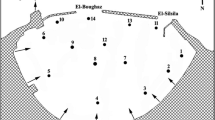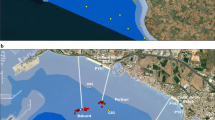Abstract
Shipwrecks may pose a serious source of pollution for marine ecosystems. For this reason, it is of great importance to perform a marine ecosystem risk assessment due to plausible wreck presence. One of elements of such an assessment is determining the state of the environment in the vicinity of the wreck. In the work presented, the results of studies on surface sediments samples collected around the s/s Stuttgart ship sunk during WW2 in the Gulf of Gdańsk (Southern Baltic) are given. 23 samples of sediments were collected and subsequently 12 metals (Cd, Co, Cr, Cu, Fe, Hg, Mg, Mo, Ni, Pb, V, Zn), 16 PAHs and 7 PCBs were determined. Metals were measured with ICP-MS and AAS while organics with GC–MS. The chemometric evaluation was performed in order to determine possible similarity patterns between the chemicals measured. Clear dependence between PAHs and PCBs was stated as well as spatial similarities between the content of the chemicals determined.








Similar content being viewed by others
References
Bajger-Nowak G, Fortuna A, Słomińska M, Marć M, Dubalska K, Rutkowska M, Kandel L, Zabiegała B, Konieczka P, Namieśnik J (2014). Homogeneity study of candidate reference material based on determination of selected metal and persistent organic compounds in soil. In: 38th international symposium on environmental analytical chemistry—ISEAC38, Lausanne, 17–20 June 2014
Bełdowski J, Pempkowiak J (2007) Mercury transformations in marine coastal sediments as derived from mercury concentration and speciation changes along source/sink transport pathway (Southern Baltic). Estuar Coastal Shelf Sci 72:370–377
Belzunce Segarra MJ, Szefer P, Wilson MJ, Bacon J, Bolałek J (2007) Chemical forms and distribution of heavy metals in core sediments from the Gdansk Basin. Baltic Sea Polish J Environ Stud 16:505–515
Benavides A, Everett ME, Pierce C Jr (2009) Unexploded ordnance discrimination using time-domain electromagnetic induction and self-organizing maps. Stoch Environ Res Risk Assess 23:169–179
Corazza MZ, Abra T, Grandis Lepri F, Gimenez SMN, Oliveira E, Santos MJ (2012) Monte Carlo method applied to modeling copper transport in river sediments. Stoch Environ Res Risk Assess 26:1063–1079
Davutluoglu OI, Seckin G, Ersu CB, Yilmaz T, Sari B (2011) Heavy metal content and distribution in surface sediments of the Seyhan River. Turkey J Environ Manage 92:2250–2259
Dubiella-Jackowska A, Kudłak B, Polkowska Ż, Namieśnik J (2009) Environmental fate of traffic-derived platinum group metals. Crit Rev Anal Chem 39:251–271
Dubiella-Jackowska A, Astel A, Polkowska Ż, Staszek W, Kudłak B, Namieśnik J (2010) Atmospheric and surface water pollution interpretation in the Gdansk beltway impact range by the use of multivariate analysis. Clean Soil Air Water 38:865–876
Fahd F, Hawboldt KK, Abbassi R (2014) Developing a novel methodology for ecological risk assessment of thiosalts. Stoch Environ Res Risk Assess 28:383–391
Gajewski L, Jezionek E, Szefler K (1998) Weryfikacja fińskiej klasyfikacji zagrożenia środowiska morskiego przez wraki. IM Gdańsk 1998
Gao H, Bai J, Xiao R, Liu P, Jiang W, Wang J (2013) Levels, sources and risk assessment of trace elements in wetland soils of a typical shallow freshwater lake. China Stoch Environ Res Risk Assess 27:275–284
Guo W, Zhang H, Cui S, Xu Q, Tang Z, Gao F (2014) Assessment of the distribution and risks of organochlorine pesticides in core sediments from areas of different human activity on Lake Baiyangdian. China Stoch Environ Res Risk Assess 28:1035–1044
Hendożko E, Szefer P, Warzocha J (2010) Heavy metals in Macoma balthica and extractable metals in sediments from the southern Baltic Sea. Ecotoxicol Environ Safe 73:152–163
Kowalewska G, Konat J (1997) Distribution of polynuclear aromatic hydrocarbons (PAHs) in sediments of the southern Baltic Sea. Oceanologia 1:83–104
Koźmiński C, Michalska B, Nidzgorska-Lancewicz J (2004) Wind. w: Atlas of Climatic Resources and Hazards in Pomerania (red. Koźmiński C, Michalska B). University of Agriculture in Szczecin, Szczecin
Kudłak B, Rogowska J, Wolska L, Kałas M, Łęczyński L, Namieśnik J (2012) Toxicity assessment of sediments associated with the wreck of s/s Stuttgart in the Gulf of Gdańsk (Poland). J Environ Monit 14:1231–1236
Lischeid G (2009) Non-linear visualization and analysis of large water quality data sets: a model-free basis for efficient monitoring and risk assessment. Stoch Environ Res Risk Assess 23:977–990
Mechlińska A, Gdaniec-Pietryka M, Wolska L, Namieśnik J (2009) Evolution of models for sorption of PAH and PCB on geosorbents. Trends Anal Chem 4:466–482
Monfils R, Gilbert T, Nawadra S (2006) Sunken WWII shipwrecks of the Pacific and East Asia: the need for regional collaboration to address the potential marine pollution threat. Ocean Coastal Manage 49:779–788
Nanos N, Grigoratos T, Rodriguez Martin JA, Samara C (2014) Scale-dependent correlations between soil heavy metals and As around four coal-fired power plants of northern Greece. Stoch Environ Res Risk Assess. doi:10.1007/s00477-014-0991-3
Osuji LC, Onojake ChM (2004) Trace heavy metals associated with crude oil: a case study of Ebocha-8 oil-spill-polluted site in Niger Delta. Nigeria Chem Biodivers 1(11):1708–1715
Pazdro K (2004) Persistent organic pollutants in sediments from the Gulf of Gdansk. Ann Set Environ Prot 6:63–76
Pikkarainen AL (2007) Polychlorinated biphenyls and organochlorine pesticides in Baltic Sea sediments and bivalves. Chemosphere 68:17–24
Prego R (2003) Zinc concentration in the water column influenced by the oil spill in the vicinity of the Prestige shipwreck. Ciencas Marinas 29(1):103–108
Renner RM, Glasby GP, Szefer P (1998) Endmember analysis of heavy-metal pollution in surficial sediments from the Gulf of Gdansk and the southern Baltic Sea of Poland. Appl Geochem 13:313–318
Rogowska J, Namieśnik J (2013) Environmental risk assessment of WW II shipwreck pollution. In: Sharma SK, Sanghi R (eds) Wastewater reuse and management. Springer, London, pp 461–478
Rogowska J, Wolska L, Namieśnik J (2010) Impacts of pollution derived from ship Wrecks on the marine environment on the basis of s/s Stuttgart (Polish coast, Europe). Sci Total Environ 408:5775–5783
SOM Toolbox 2.0. Available at http://www.cis.hut.fi/projects/somtoolbox/
Szefer P, Glasby GP, Pempkowiak J, Kaliszan R (1995) Extraction studies of heavy-metal pollutants in surficial sediments from the southern Baltic Sea off Poland. Chem Geol 120:111–126
Szefer P, Glasby GP, Geldon J, Renner RM, Bjorn E, Snell J, Frech W, Warzocha J (2009) Heavy-metal pollution of sediments from the Polish exclusive economic zone, southern Baltic Sea. Environ Geol 57:847–862
USEPA (1986) Method 3050b. Acid digestion of sediment, sludge and soils. In test methods for evaluating solid wastes. EPA SW-846. US Government Printing Office, Washington, DC
Vallius H (2009) Heavy metal distribution in the modern soft surface sediments off the Finnish coast of the Gulf of Finland. Baltica 22:65–76
Williams RH, Larson ED (2003) A comparison of direct and indirect liquefaction technologies for making fluid fuels from coal. Energy Sustain Dev 4:103–129
Yu Ch, Xu Sh, Gang M, Chen G, Zhou L (2011) Molybdenum pollution and speciation in Nver River sediments impacted with Mo mining activities in western Liaoning, northeast China. Int J Environ Res 5(1):205–212
Acknowledgments
The Authors would like to thank the Polish Ministry of Science and Higher Education (project no. 4221/B/T02/2009/37) for funding this research.
Author information
Authors and Affiliations
Corresponding author
Rights and permissions
About this article
Cite this article
Rogowska, J., Kudłak, B., Tsakovski, S. et al. Surface sediments pollution due to shipwreck s/s “Stuttgart”: a multidisciplinary approach. Stoch Environ Res Risk Assess 29, 1797–1807 (2015). https://doi.org/10.1007/s00477-015-1054-0
Published:
Issue Date:
DOI: https://doi.org/10.1007/s00477-015-1054-0




